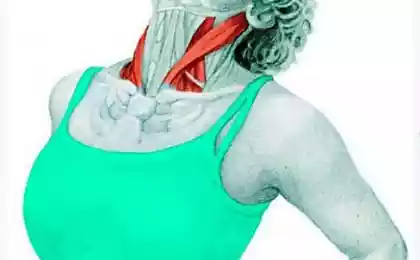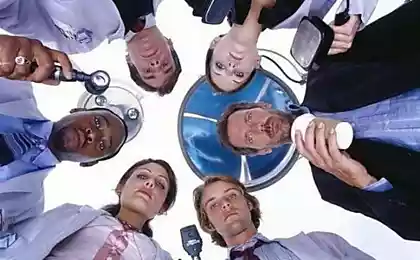681
Syndrome scalene muscle. Treatment using trigger points
Syndrome scalene muscle (also called scalenus syndrome) a group of symptoms including pain, numbness and weakness in the neck, shoulder or hands.
The cause of the symptoms is compression or damage to nerves or vessels in the costoclavicular interval. Costoclavicular interval is located between the collarbone and the top rib, on both sides of the body.
Seventy two million two hundred seven thousand five hundred seventy seven
The majority of vessels (arteries and veins) and nerves supplying the hand pass through this space. Narrowing of this space can result in compression of nerves and blood vessels that disrupts the normal functioning of the upper limbs.
The reason for the narrowing can be different conditions such as: trauma, obesity, congenital anomalies, disorders of posture. But sometimes, can't figure out the exact cause of the constriction.
Syndrome scalene muscle may be the cause of significant pain syndrome and can affect many aspects of life ( health, recreation, physical activity). Often its diagnosis is difficult.
In the absence of adequate treatment, this syndrome may cause nerve damage blood vessels and even sometimes to atrophy of the limbs. Currently, treatment of this syndrome quite successfully.
The appearance of the syndrome scalene muscle is the result of compression of nerves or vessels at the outlet of the thorax.
Main reason:
Group of scalene muscles consist of three muscles:
As a rule, they are fastened to the side parts of the cervical vertebrae and upper ribs. Scalene muscle responsible for lateral movement of the head. They also result in movement of the neck, and breathing muscles, as pulling the ribs up.
Symptoms:
To get rid of such problems will help massage the trigger points, located in the scalene muscles.
Twenty nine million four hundred sixty six thousand nine hundred eighty one
A complex picture of pain caused by trigger points located in the anterior, middle and posterior scalene muscles. Some trigger points may have only one ongoing area otrajenii pain.
Solid red shows the basic area of pain, granular area of referred pain.
The trigger point is the point which projects the reflected pain. John. Travel and Simons in the book "Myofascial pain and dysfunction. Guide to trigger points", described trigger points as hyperexcitable areas with local muscle tension, located in the skeletal muscle and associated fascia.
The appearance and the appearance of trigger points happens when you overstrain, long and constant load of muscles and muscle groups in the body.
Trigger points tend to occur where physical activity or postural stress cause marked stress or poor circulation.
These loads are associated with the body position: hunched shoulders, downcast and tense chest, shibliani back, excessive deflection in the lower back.
The presence and localization of spastic muscles affected through the physical and emotional factors on the position of man, his ability to move and opportunity to act in a physiologically optimum way, but also affects other physiological parameters, blood flow, lymph flow and innervation.
Trigger points can be localized in any muscle of the body.
Trigger point massage is performed using acupressure or ischemic compression.
Gradual, gradual and slow pressure on the trigger point, until you will not feel the hard resistance of the fabric, the wait for 10-12 seconds while maintaining pressure on the point, then continue pressing until further resistance of fabrics.
Eco-friendly cosmetics: natural deodorant — 3 recipe
The definition of trigger points on the body
The pressing continues until full resistance of muscle tissues. May continue for up to 1 minute. After a smooth and slow exit point.
Effects also may include the actual acupuncture or the use of local anesthesia, or injections of analgesics or saline solution.
Treatment can be completed by the imposition of a moist hot compress, it helps to improve blood circulation in the affected muscle.published
P. S. And remember, only by changing their consumption — together we change the world! ©
Source: xn--80ajkvbglie5k.com.ua/?p=147#more-147
The cause of the symptoms is compression or damage to nerves or vessels in the costoclavicular interval. Costoclavicular interval is located between the collarbone and the top rib, on both sides of the body.
Seventy two million two hundred seven thousand five hundred seventy seven
The majority of vessels (arteries and veins) and nerves supplying the hand pass through this space. Narrowing of this space can result in compression of nerves and blood vessels that disrupts the normal functioning of the upper limbs.
The reason for the narrowing can be different conditions such as: trauma, obesity, congenital anomalies, disorders of posture. But sometimes, can't figure out the exact cause of the constriction.
Syndrome scalene muscle may be the cause of significant pain syndrome and can affect many aspects of life ( health, recreation, physical activity). Often its diagnosis is difficult.
In the absence of adequate treatment, this syndrome may cause nerve damage blood vessels and even sometimes to atrophy of the limbs. Currently, treatment of this syndrome quite successfully.
The appearance of the syndrome scalene muscle is the result of compression of nerves or vessels at the outlet of the thorax.
Main reason:
- Injury Traumatic episode can cause damage to bone or soft tissue at the outlet of the thorax. Most people with SLM in history was a particular episode of an accident, injury at work or in the home.
- Congenital anomaly such as an extra rib or tight ligament that connects the spine to the edge, can reduce the costoclavicular interval.
- Violation of posture – shoulders sagging, or excessive tilt of the head forward can provide compression to the region of the exit of nerves and vessels of the thorax.
- Frequent repetitive motion can lead to wear of the tissues and lead to SLM. An example may be the motion associated with lifting hands (down the clavicle and costoclavicular interval decreases), for example swimming, baseball, tennis, weightlifting.
- Other reason – Weight gain (pregnancy or obesity), the excessively developed muscles of the neck (from weight-lifting or martial arts), or long-term fixation of the hand in one position (work computer) could put further pressure on the nerves and blood vessels. Disease in which disrupted the function of the nerves, such as hypothyroidism and diabetes can be contributing factors neurogenic SLM.
Group of scalene muscles consist of three muscles:
- anterior scalene muscle;
- the middle scalene muscle;
- back scalene muscle.
As a rule, they are fastened to the side parts of the cervical vertebrae and upper ribs. Scalene muscle responsible for lateral movement of the head. They also result in movement of the neck, and breathing muscles, as pulling the ribs up.
Symptoms:
- pain in the upper back (especially on the inner side of the blade);
- neck pain;
- pain in the side of the face;
- pain in the upper part of the chest;
- shoulder pain;
- pain in the hands;
- syndrome scalene muscle;
- the lump in my throat;
- hoarseness;
- syndrome of the temporomandibular joint.
To get rid of such problems will help massage the trigger points, located in the scalene muscles.
Twenty nine million four hundred sixty six thousand nine hundred eighty one
A complex picture of pain caused by trigger points located in the anterior, middle and posterior scalene muscles. Some trigger points may have only one ongoing area otrajenii pain.
Solid red shows the basic area of pain, granular area of referred pain.
The trigger point is the point which projects the reflected pain. John. Travel and Simons in the book "Myofascial pain and dysfunction. Guide to trigger points", described trigger points as hyperexcitable areas with local muscle tension, located in the skeletal muscle and associated fascia.
The appearance and the appearance of trigger points happens when you overstrain, long and constant load of muscles and muscle groups in the body.
Trigger points tend to occur where physical activity or postural stress cause marked stress or poor circulation.
These loads are associated with the body position: hunched shoulders, downcast and tense chest, shibliani back, excessive deflection in the lower back.
The presence and localization of spastic muscles affected through the physical and emotional factors on the position of man, his ability to move and opportunity to act in a physiologically optimum way, but also affects other physiological parameters, blood flow, lymph flow and innervation.
Trigger points can be localized in any muscle of the body.
Trigger point massage is performed using acupressure or ischemic compression.
Gradual, gradual and slow pressure on the trigger point, until you will not feel the hard resistance of the fabric, the wait for 10-12 seconds while maintaining pressure on the point, then continue pressing until further resistance of fabrics.
Eco-friendly cosmetics: natural deodorant — 3 recipe
The definition of trigger points on the body
The pressing continues until full resistance of muscle tissues. May continue for up to 1 minute. After a smooth and slow exit point.
Effects also may include the actual acupuncture or the use of local anesthesia, or injections of analgesics or saline solution.
Treatment can be completed by the imposition of a moist hot compress, it helps to improve blood circulation in the affected muscle.published
P. S. And remember, only by changing their consumption — together we change the world! ©
Source: xn--80ajkvbglie5k.com.ua/?p=147#more-147























